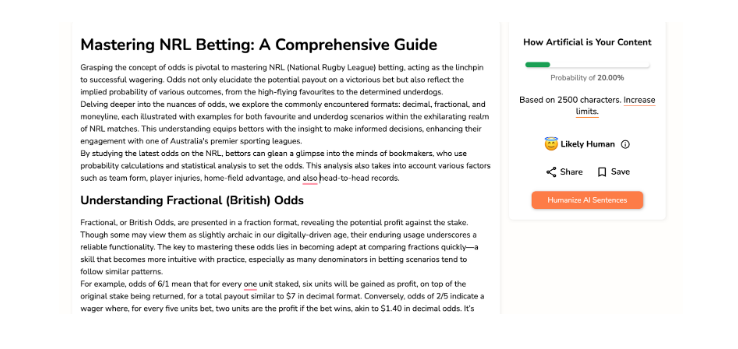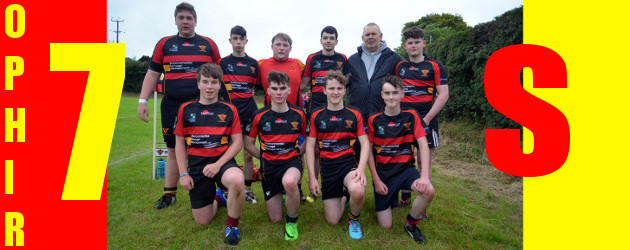Mastering NRL Betting: A Comprehensive Guide
Grasping the concept of odds is pivotal to mastering NRL (National Rugby League) betting, acting as the linchpin to successful wagering. Odds not only elucidate the potential payout on a victorious bet but also reflect the implied probability of various outcomes, from the high-flying favourites to the determined underdogs.
Delving deeper into the nuances of odds, we explore the commonly encountered formats: decimal, fractional, and moneyline, each illustrated with examples for both favourite and underdog scenarios within the exhilarating realm of NRL matches. This understanding equips bettors with the insight to make informed decisions, enhancing their engagement with one of Australia’s premier sporting leagues.
By studying the latest odds on the NRL, bettors can glean a glimpse into the minds of bookmakers, who use probability calculations and statistical analysis to set the odds. This analysis also takes into account various factors such as team form, player injuries, home-field advantage, and head-to-head records.
Understanding Fractional (British) Odds
Fractional, or British Odds, are presented in a fraction format, revealing the potential profit against the stake. Though some may view them as slightly archaic in our digitally-driven age, their enduring usage underscores a reliable functionality. The key to mastering these odds lies in becoming adept at comparing fractions quickly—a skill that becomes more intuitive with practice, especially as many denominators in betting scenarios tend to follow similar patterns.
For example, odds of 6/1 mean that for every one unit staked, six units will be gained as profit, on top of the original stake being returned, for a total payout similar to $7 in decimal format. Conversely, odds of 2/5 indicate a wager where, for every five units bet, two units are the profit if the bet wins, akin to $1.40 in decimal odds. It’s common to encounter a 9/10 line in many line bets, signalling a scenario where a nine-unit profit is made from a ten-unit stake, equivalent to $1.90 in decimal odds.
While it may initially appear daunting, this system facilitates a clear understanding of profit-to-stake ratios and enhances strategic betting decisions in NRL wagering.
Deciphering Moneyline Odds
Moneyline, or American Odds, stand out due to their unique approach to presenting odds, which may initially seem unconventional to those accustomed to the Australian betting landscape. This format excels in its straightforward representation of the relationship between wagers on favourites and underdogs. Specifically, betting on a favourite with Moneyline odds ensures a profit of one unit for every unit wagered, whereas backing an underdog involves staking one unit to potentially earn more. This duality simplifies understanding the risk and reward principle inherent in sports betting, promoting a balanced return from the bookmaker.
Additionally, Moneyline odds are invaluable for bettors seeking arbitrage opportunities, offering clear indications when the sum of the odds, such as -250 and +600, creates a favourable scenario (signified when the combined figures exceed zero). Symbols play a critical role in this system: a “+” indicates underdog status, showing the profit for every 100 units bet, while a “-” suggests a favourite, denoting the amount required to win 100 units.
In the context of the NRL, favourites might be listed at -250 (requiring a 250-unit bet to win 100 units, equivalent to Decimal Odds of $1.40), and underdogs at +600 (where a 100-unit bet yields a 600-unit profit, mirroring Decimal Odds of $7). Line bets commonly feature -110 lines at reputable bookmakers, streamlining the betting process for aficionados.
Navigating Decimal (European) Odds
In Australia, where the majority of our readers are likely placing their wagers, decimal odds reign supreme. This format is probably what you’re most familiar with, offering a straightforward approach to calculation and comparison. However, it’s crucial to approach these odds with a critical eye—they can sometimes obscure the true value of a bet. For instance, underdog bets might present decimal odds of $7.00, and favourites may offer $1.40.
To discern the implied probability, one can simply take the inverse of the decimal odds (for those versed in Excel, this is calculated as =x^-1, where x represents the decimal odds). To illustrate, odds of $2.00 imply a 50% chance of winning (1/2), while odds of $5.00 suggest a 20% winning probability (1/5). While decimal odds facilitate easy mathematical operations, remember their ease can also disguise a bet’s true worth. Understanding and leveraging this can significantly enhance your NRL betting strategy.
Mastering Implied Probability in NRL Betting
Implied probability is a sophisticated concept that underpins the calculations made by bookmakers when setting the odds. It informs bettors of the bookmaker’s perspective on the likelihood of various outcomes, encapsulated in percentages. This figure is crucial because it factors in the vigorish or market percentage, ensuring the total implied probability across all possible outcomes exceeds 100%. This overround is how bookmakers secure their profit margin. A disparity in this calculation can signal an arbitrage opportunity—a rare but valuable find for the astute gambler.
However, despite its significance, many bettors seldom utilise implied probability directly. Yet, understanding and applying it can uncover the true value of a bet. For instance, if your predictive model suggests Team A has a 60% chance of winning, but the bookmaker’s decimal odds of $1.91 only imply a 52.4% chance of victory, your model indicates a potential edge of 7.6% in favour of betting on Team A. This numerical edge can be the difference between a strategic bet and a gamble.
From an analytical standpoint, implied probability also serves as a benchmark for evaluating a betting model’s effectiveness. It essentially outlines the minimum win rate (strike rate) a model should predict at given odds to break even over time. If your model’s projected win rate falls short of this threshold, it may be time for recalibration. Understanding and applying implied probability enhances your NRL betting strategies, moving you closer to mastering the art of profitable wagering.










